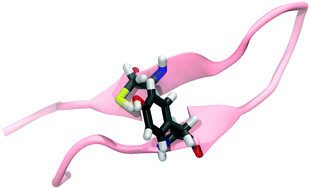Tyrosine, cysteine, and proton coupled electron transfer in a ribonucleotide reductase-inspired beta hairpin maquette†
Abstract
Tyrosine residues act as intermediates in proton coupled electron transfer reactions (PCET) in proteins. For example, in ribonucleotide reductase (RNR), a tyrosyl radical oxidizes an active site cysteine via a 35 Å pathway that contains multiple aromatic groups. When singlet tyrosine is oxidized, the radical becomes a strong acid, and proton transfer reactions, which are coupled with the redox reaction, may be used to control reaction rate. Here, we characterize a tyrosine-containing beta hairpin, Peptide O, which has a cross-strand, noncovalent interaction between its single tyrosine, Y5, and a cysteine (C14). Circular dichroism provides evidence for a thermostable beta-turn. EPR spectroscopy shows that Peptide O forms a neutral tyrosyl radical after UV photolysis at 160 K. Molecular dynamics simulations support a phenolic/SH interaction in the tyrosine singlet and radical states. Differential pulse voltammetry exhibits pH dependence consistent with the formation of a neutral tyrosyl radical and a pKa change in two other residues. A redox-coupled decrease in cysteine pKa from 9 (singlet) to 6.9 (radical) is assigned. At pD 11, picosecond transient absorption spectroscopy after UV photolysis monitors tyrosyl radical recombination via electron transfer (ET). The ET rate in Peptide O is indistinguishable from the ET rates observed in peptides containing a histidine and a cyclohexylalanine (Cha) at position 14. However, at pD 9, the tyrosyl radical decays via PCET, and the decay rate is slowed, when compared to the histidine 14 variant. Notably, the decay rate is accelerated, when compared to the Cha 14 variant. We conclude that redox coupling between tyrosine and cysteine can act as a PCET control mechanism in proteins.

- This article is part of the themed collection: Frontiers in Proton Coupled Electron Transfer (PCET)


 Please wait while we load your content...
Please wait while we load your content...
